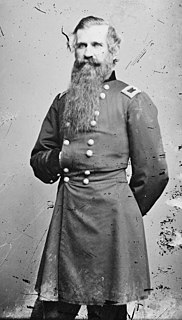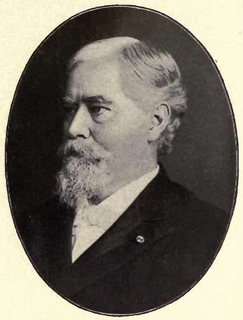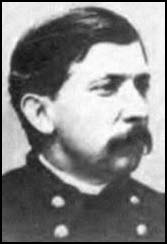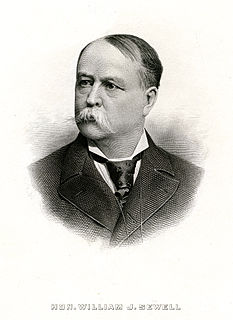
Paul Ambrose Oliver was an American explosives inventor, American Civil War Union Army captain and staff officer who was appointed to the brevet grade of brigadier general and Medal of Honor recipient. He was born on the "Louisiana", his father's merchant ship, during one of its voyages in the English Channel. Before the Civil War, he worked as a shipping merchant.

Wager Swayne was a Union Army colonel during the American Civil War who eventually was appointed as the last major general of volunteers of the Union Army. Swayne received America's highest military decoration the Medal of Honor for his actions at the Second Battle of Corinth. He also was effectively the military governor of Alabama from March 2, 1867 to July 14, 1868 after the passage of the first Reconstruction Act by the U.S. Congress until Alabama was readmitted to the Union. Robert M. Patton remained the nominal governor during this period but as the local army commander, Swayne controlled the State government.

John Cleveland Robinson had a long and distinguished career in the United States Army, fighting in numerous wars and culminating his career as a Union Army brigadier general of volunteers and brevet major general of volunteers in the American Civil War. In 1866, President Andrew Johnson nominated and the U.S. Senate confirmed Robinson's appointment to the brevet grade of major general in the regular army. He was a recipient of the Medal of Honor for valor in action in 1864 near Spotsylvania Courthouse, Virginia, where he lost a leg. When he retired from the U.S. Army on May 6, 1869, he was placed on the retired list as a full rank major general, USA. After his army service, he was Lieutenant Governor of New York from 1873 to 1874 and served two terms as the president of the Grand Army of the Republic.

John Charles Black was a Democratic U.S. Congressman and received the Medal of Honor for his actions as a Union Army lieutenant colonel and regimental commander at the Battle of Prairie Grove during the American Civil War.

James William Forsyth was a U.S. Army officer and general. He was primarily a Union staff officer during the American Civil War and cavalry regimental commander during the Indian Wars. Forsyth is best known for having commanded the 7th Cavalry at the Wounded Knee Massacre on December 29, 1890 during which more than 150 men, women, and children of the Lakota were killed and 51 were wounded.

Theophilus Francis Rodenbough was born in Easton, Pennsylvania and was a Union Army officer during the American Civil War. He received America's highest military decoration the Medal of Honor for his actions at the Battle of Trevilian Station. After his retirement from the U.S. Army in 1870, he wrote several books about military history.

William Joyce Sewell was an Irish-American politician, merchant, and military officer who served as a U.S. Senator from New Jersey. Sewell was born in Castlebar, County Mayo, Ireland. He immigrated to the United States in 1851 where he worked in the merchant industry in Chicago, Illinois before moving to Camden, New Jersey in 1860. He served as an officer in the Union Army during the American Civil War, receiving the Medal of Honor for his actions at the Battle of Chancellorsville. He was also a postbellum state senator and U.S. Senator. The community of Sewell, New Jersey is named for him.

Charles Edward Phelps was a colonel in the Union Army during the Civil War, later received a brevet as a brigadier general of volunteers, served as a city councilman, a U.S. Congressman from the third district of Maryland, and received the Medal of Honor. In later life, he was professor of equity at University of Maryland Law School, and served for many years as Judge of the Circuit Court of Baltimore.
George Nelson Morgan was a Union Army officer in the American Civil War.

George Henry Cram was a colonel in the Union Army during the American Civil War. He was nominated and confirmed for appointment to the grade of brevet brigadier general in 1867 in recognition of his performance during the war.

Orlando Bolivar Willcox was an American soldier who served as a general in the Union Army during the American Civil War.

Aaron Simon Daggett was a career United States Army officer. He was the last surviving brevet Union general of the American Civil War, and the last surviving general of any grade from the war, when he died at the age of 100 in 1938. Daggett was nominated for appointment to the grade of brevet brigadier general, to rank from March 13, 1865, by President Andrew Johnson on February 21, 1866 and was confirmed by the United States Senate on April 10, 1866. During the war, Daggett fought at West Point, Gaines' Mill, Golding's Farm, White Oak Swamp, Second Bull Run, South Mountain, Antietam, Rappahannock Station, Fredericksburg, Battle of Gettysburg, Battle of Mine Run, Battle of the Wilderness and Battle of Cold Harbor. Daggett was a brigadier general of volunteers in the Spanish–American War. He was appointed to the brigadier general grade to rank from September 1, 1898 and was mustered out of the volunteers on November 30, 1898. He was promoted to brigadier general in the Regular Army ten days before his retirement from the army on March 2, 1901.

Absalom Baird was a career United States Army officer who distinguished himself as a Union Army general in the American Civil War. Baird received the Medal of Honor for his military actions.

Cecil Clay was captain of Company K in the 58th Pennsylvania Volunteer Infantry Regiment in the Union Army during the American Civil War. He performed gallantly while wounded, earning the Medal of Honor for his actions during the assault and capture of Fort Harrison, Virginia in the Confederate defenses of Richmond, Virginia on September 29, 1864. He was later chief clerk of the United States Department of Justice.

St. Clair Augustine Mulholland was a colonel in the Union Army in the American Civil War who later received the brevets of brigadier general of volunteers and major general of volunteers and the Medal of Honor for gallantry in action at the Battle of Chancellorsville.

Thomas Worcester Hyde was a Union Army colonel who subsequently received brevets of brigadier general of volunteers and major general of volunteers in the American Civil War, a state senator from Maine, and the founder of Bath Iron Works, one of the major shipyards in the United States. He wrote two books about his experiences during the war and at the Battle of Gettysburg.

Ernst Mathias Peter von Vegesack was a Swedish Army officer and volunteer in the Union Army during American Civil War and later on was a member of the parliament of Sweden. After his return to Sweden, he was awarded the brevet grade of Brigadier general of volunteers and in 1893 he received the Medal of Honor for bravery in the Battle of Gaines's Mill.

Alfred Lawrence Pearson was a lawyer and Union Army general in the American Civil War. He was awarded the U.S. military's highest decoration, the Medal of Honor, for his actions at the Battle of Lewis's Farm.
William Herbert Withington was a Union Army officer during the American Civil War.
Adrian Rowe Root was an American commission merchant, warehouse executive, newspaper editor and military officer in the Union Army during the American Civil War. He served as brigade commander for much of the war but his highest actual substantive grade was colonel. His March 2, 1865 nomination for appointment as brevet brigadier general of volunteers to rank from March 2, 1865, was confirmed by the United States Senate on March 9, 1865. His January 13, 1866 nomination for appointment as a brevet major general of volunteers, to rank from March 13, 1865, was confirmed by the U.S. Senate on March 12, 1866.

















